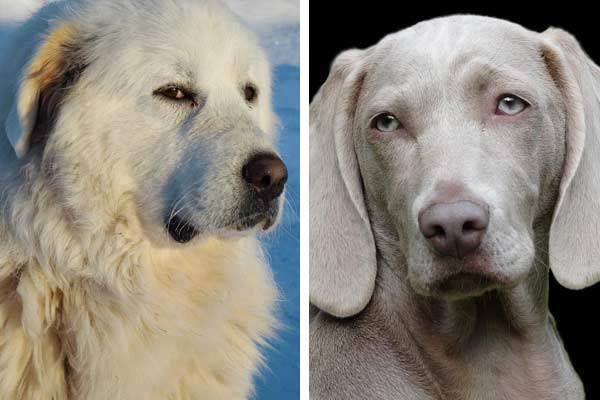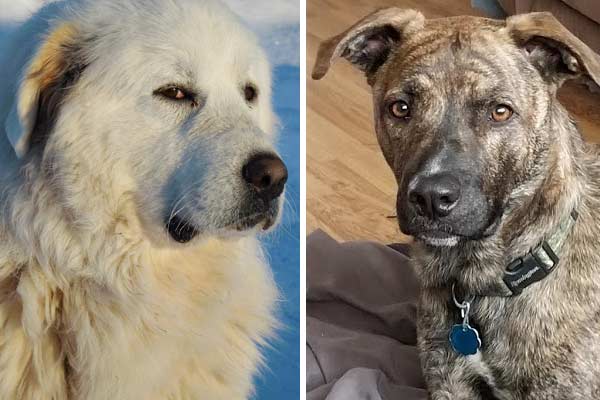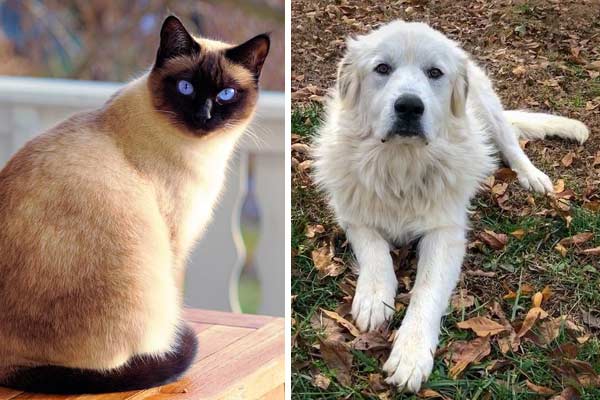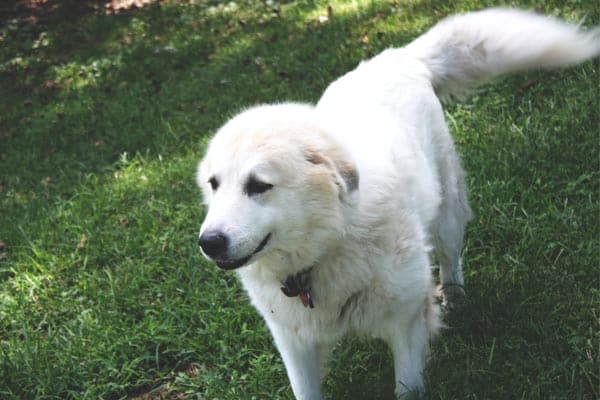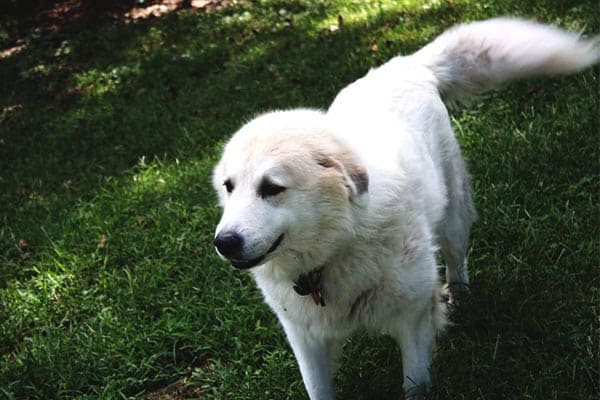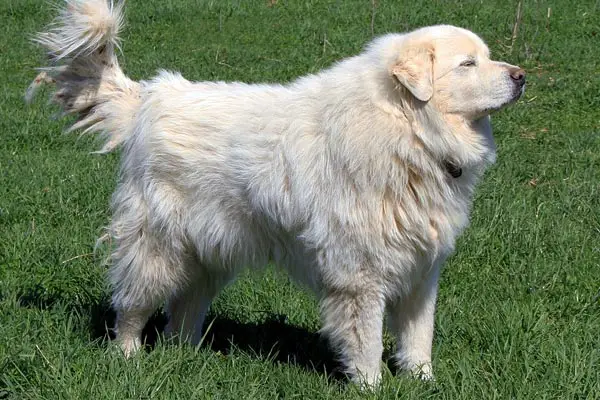Are Great Pyrenees Aggressive? What You Should Know
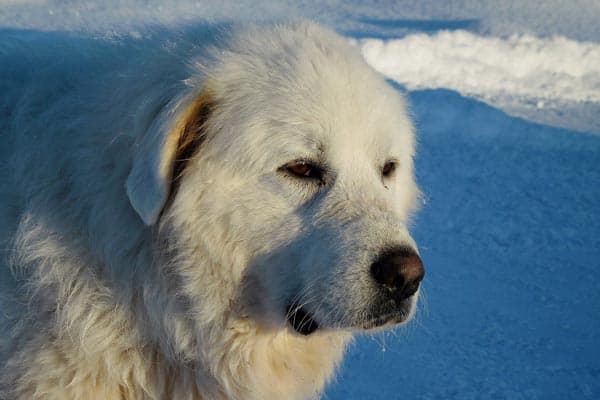
If you ever thought about acquiring the Great Pyrenees as your next pet, you likely asked one of the top questions everyone has about large breeds.
Are Great Pyrenees aggressive? And you are likely not interested in the generic answer that says any dog can be aggressive.
Potential owners want to address pertinent issues such as how inclined a breed is to attack or bite and under what circumstances.
The Great Pyrenees has a low to medium tendency towards aggression depending upon its degree of socialization and use.
Compared to other breeds, Great Pyrs are less aggressive than fighting and guard breeds but more prone to hostile behaviors than many of the sporting or gundogs.
Aggressiveness in Pyrs mostly stems from the protectiveness associated with being a livestock guardian dog, poor socialization, or lack of discipline.
You will witness that the Great Pyrenees’ aggression falls into several categories such as fear or lack of training.
Great Pyrenees’ basic temperament is not aggressive
The Great Pyrenees is a large to giant breed of dog. Males average 29 or 30 inches tall at the shoulders and can weigh up to 160 pounds. Females are smaller but still impressive at 27 inches tall and 80 to 120 pounds.
Despite its size, the Great Pyrenees should not be innately aggressive towards people or other animals. However, it must exhibit ferocity against any animal or person that threatens its flock.
The Great Pyrenees temperament is calm, steady, and trustworthy. Pyrs are not prone to much playfulness beyond puppyhood. They are gentle with their charges and affectionate with their families.
Great Pyrenees are strong-willed and independent thinkers, willing and able to make critical decisions about their flocks.
Therefore, if your Pyr decides to physically confront an intruder, you will not be able to call her off like an attack dog. Other elements of her disposition are courage and confidence.
The Great Pyrenees often shows coolness towards strangers and may not have any interest in garnering new friendships.
Great Pyrenees do not show all forms of canine aggression
Canine aggression takes on numerous roles.
- Owner aggression – spaniels and Beagles; dog shows continual aggression against its owner
- Fear aggression – family lines of GSD and others, unsocialized dogs, abused dogs
- Social Aggression – any dog
- Guarding instinct aggression (stranger aggression)- Rottweiler, Doberman, GSD, others
- Pain or illness aggression – any dog
- Prey drive – wolf hybrid, herding dogs, hunting dogs, huskies
- Protection aggression – some guard dogs, livestock guardian dogs
- Dog aggression – same gender, breed aggression, territorial aggression, sibling rivalry
- Resource aggression – guard food, toys, bedding; any breed
- Dominance aggression – GSD more common, any breed but rare
How do you combat social aggression in the Great Pyrenees?
You can see three major forms of unwanted aggression in your Great Pyrenees dog if you fail to socialize her as a young puppy.
Lack of discipline which you should accomplish through training can also lead to social aggression.
- Indiscriminate aggression towards people – can result in unprovoked attacks
- Misplaced dog aggression – your dog wants to fight other dogs even in a nonprotective capacity; sees every dog as a threat
- Livestock – a Great Pyrenees does not learn how to interact appropriately with livestock and plays with animals or chases them to injury or death; some early deaths among poultry are common with pups in training
People often underestimate fear aggression in Great Pyrenees.
The Great Pyrenees is typically a confident, self-assured, and brave dog. Anything less is a serious fault according to the AKC breed standard of character.
Courage and security are crucial to a livestock guardian dog. However, not all Great Pyrenees are fearless. What is more, many dog lovers might dismiss a fearful dog as harmless, but that is not necessarily the case.
While most dogs that feel fear will cower and slink away or hide, they are also in a fight or flight emotional state.
If the avenues they prefer to take, like avoidance or retreat, become blocked, then you force them to fight. Such dogs are dangerous and will attack with the ferocity of a protective or guard canine.
The Great Pyrenees is not a breed marked by family lines that pass on fear, but they sometimes have more anxiety than normal.
An anxious dog can become fearful if you never address the source of her anxiety. Some anxiety is genetic, and you may have to try behavior modification, desensitization, or medication.
- Separation – you think of Pyrs as independent, but without a job, they can become anxious if you leave them for extended periods
- Bad experience
- Harsh training methods – Great Pyrenees are sensitive, but their willful natures make it tempting to resort to force or verbal reprimand
You can also cultivate fear in an anxious dog if you neglect socializing her. Many times, fear is a direct result of a lack of socialization. If you do not expose your pup to strange people, noises, animals, and places, she easily can become frightened of her own shadow.
The critical age of optimal socialization ends between 12 and 16 weeks. Although socialization for the Great Pyrenees is ongoing, missing the formative weeks can create a fear-aggressive adult.
The Great Pyrenees’ job requires protection aggression
The Great Pyrenees is designed to be protective of his flock. A flock can refer to any group that an LGD deems his charges.
- Family members, especially vulnerable children; for a house pet, it is often everyone in the home, even including small dogs and cats
- Sheep, goats, cattle, horses
- Ducks, chickens, geese
Great Pyrenees display protection aggression against any perceived threat to their flock. While you usually think of wolves, foxes, coyotes, bears, and panthers, these dogs also guard against human intruders as potential livestock thieves.
A Pyr, like most guard dogs, usually attacks as a last resort. Its first approach is to announce its presence through regular barking. Then the Pyr will insert himself between the threat and the herd or flock.
A promise of a physical confrontation ensues from the Great Pyrenees with an alarm and an attempt at intimidation through barking, growling, snarling, charging, and making itself appear larger.
If intimidation is not effective, the Great Pyrenees’ aggression progresses to a vigorous pursuit. An insufficient retreat on the part of the predator or rustler will result in the escalation of the attack to potentially lethal force.
As an LGD, a Pyr exhibits only moderate aggression, rarely having to engage in confrontations.
Usually, the mere presence of a Great Pyrenees is enough to deter predators and human trespassers.
However, people may disregard the dangers of a Pyr that serves as a household pet because the breed is not an official guard dog.
Luckily, the Pyr’s booming bark is certain to ward off any would-be nefarious acts before they occur, negating the need for attack.
Dog aggression is usually a product of protectiveness
The Great Pyrenees is generally a team player with other dogs unless she thinks they are threatening her flock. Pyrs on duty should be naturally more suspicious of strange dogs than Great Pyrenees that live inside the home full-time.
A working Great Pyrenees will treat an unfamiliar dog much like they would a canine predator such as a coyote.
Your training and socialization should educate your dog on other LGDs on the farm and any herding dogs you may use. Indiscriminate canine aggression can be quite inconvenient if you want to work with multiple dogs.
Other factors can contribute to the Great Pyrenees’ dog aggression.
- Same-gender rivalry – can happen with males or females
- Territorial aggression – more common with intact males
- Poor socialization – effective tool is to have established LGDs help raise upcoming generations
- Combat over mating privileges – intact males
Is dominance aggression a thing with the Great Pyrenees?
Despite their Strong will and resistance to training, dominance aggression in the Pyrenean Mountain Dog is uncommon. When you have a problem, hiring a professional trainer is usually the route to take.
Mild cases of dominance aggression are relatively simple to manage by establishing strong leadership boundaries.
- You give your dog meals in a sit-stay
- Your Great Pyrenees is not allowed on your bed or any other furniture
- Hard work on impulse control
- More exercise
- Increased mental stimulation and obedience training
Severe cases of dominance aggression, which would be exceedingly rare in the Great Pyrenees, may require medication in addition to behavior modification.
How do you measure Great Pyrenees’ aggression?
A Great Pyrenees guarding sheep or goats in the field will become provoked to attack much more readily than a pet inside the home.
A Pyr that grows up with exposure to many types of people will have very low aggression. However, the question, “Are Great Pyrenees aggressive?” warrants some comparisons with other types and breeds of dogs.
Livestock Guardian Dogs
The Great Pyrenees rivals the Maremma Sheepdog in friendliness to humans, although aloof with strangers, as mentioned.
Breeds like the Anatolian Shepherd and Akbash are notably more aggressive towards people, sometimes barely tolerant of too much contact with their handlers.
Kuvaszok can also be aggressive with people, often forming permanent opinions about individuals early in their introductions.
The Great Pyrenees are also in the middle of the road in terms of their aggression towards predators.
Although all are highly effective at deterring predators, some of the LGDs are more aggressive than the Pyrs.
LGDs are accepted as a nonlethal approach to predator control around livestock, but some breeds will give chase earlier and for longer than a Great Pyrenees. It is not necessarily better or worse but signifies increased aggression over the Pyrenees.
LGDs are not the most aggressive dogs
Several lists seek to designate the most vicious or aggressive breeds of dogs. Most scientific classifications make use of objective data such as the proportion of injuries and bites to humans.
Some breeds show up consistently on multiple numbered lists from different sources while others come and go. Repeat offenders are listed below.
- American Pitbull Terrier
- Rottweiler
- German Shepherd
- Chow Chow
- Wolf hybrid
- Doberman Pinscher
- Akita
- Boerboel – South African Mastiff
- Rhodesian Ridgeback
Dogs that show up occasionally, such as the Great Dane and Cocker Spaniel, once had terrible reputations for aggression.
The Great Dane is still considered one of the most dangerous dogs because of its size. Recent aggressive dog lists cite the Miniature Poodle, Miniature Schnauzer, and Rough-Coated Collie, reflecting changes in popularity and the fallacies of careless breeding for looks.
LGDs do not show up in any vicious dog references except when classifying the Anatolian Shepherd as a Kangal. The Kangal is banned in a few locales, probably motivated in part by a bite force of over 750 PSI.
Aggression is marked by several features other than biting:
- Lunging
- Barking
- Menacing glare
- Growling or snarling
- Barreling into people, knocking them over – Rottweiler
- Baring teeth – Chow Chow commonly exposes a canine tooth by curling the lip
- Jumping on people to stare them in the eye – Akita
- Urinating on people or their possessions
- Humping
Example
Hudson shows aggression that is typical of many Great Pyrenees. The report is that he is protective of his family, which he has probably decided is his flock.
He also shows resource guarding in the kennel and perhaps some territorial aggression as well.
When he starts his professional training, you can see there is no eagerness to make friends with his handler although he obeys the commands.
His obedience seems to come reluctantly, and it is difficult to tell if that is an expression of some aggression or just the expected Great Pyrenees’ willfulness.
You can see the dog’s ultimate unwillingness to carry through with a bite. If pushed much further, he probably would attack.
